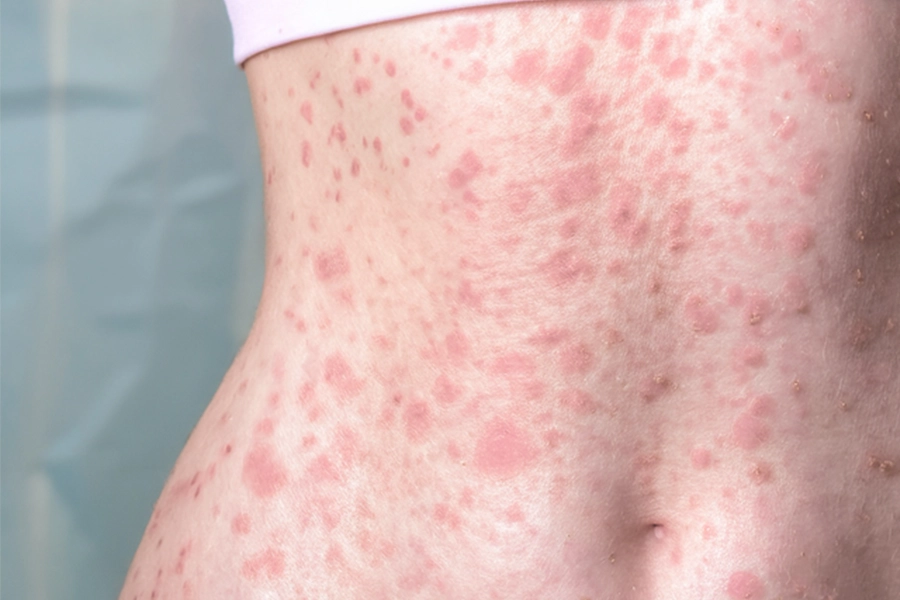Highly contagious measles outbreaks have been reported in several countries, with a significant surge centered in West Texas and spreading into New Mexico and Oklahoma. More than 250 cases have been confirmed across these three states, yet experts warn that the actual number may be much higher.1
What makes this outbreak particularly alarming is that measles is a vaccine-preventable disease. Despite the availability of a safe and effective vaccine, many individuals remain unvaccinated, leading to the resurgence of a disease that was once nearly eradicated. But why is this happening? Is it due to a lack of awareness, misinformation, religious beliefs or deeply rooted cultural perspectives?
In an era of rapid technological and medical advancements, where information is at our fingertips, why do vaccine hesitancy and refusal persist? Addressing these concerns is crucial to preventing further outbreaks and safeguarding public health.
This article provides a detailed explanation of measles, emphasizing the importance of education in disease prevention.
Raising awareness about measles and its risks is essential, as it can help reduce unnecessary exposure, such as intentionally contracting the disease through practices like measles parties.
Introduction
Measles, also known as Rubeola, is a highly contagious and potentially life-threatening disease caused by the measles virus, a member of the Paramyxoviridae family and the Morbillivirus genus.2,3 The measles virus is an enveloped, single-stranded RNA virus with a negative-sense, non-segmented genome that encodes at least six structural proteins.4 This virus is responsible for more than 100,000 deaths annually, primarily among children under five years.5 However, this represents a significant decline in fatalities, from more than 2 million annually before the introduction and widespread use of the measles vaccine.6
The Measles virus is transmitted through aerosols and respiratory droplets. It spreads when an infected person coughs, sneezes or talks, releasing virus-laden droplets into the air. These droplets can remain suspended for up to 2 hours in the air, making measles highly contagious.7
The pathogenesis of measles virus begins when the virus is inhaled and infects CD150+ immune cells including T-cells, B-cells, dendritic cells and macrophages, in the respiratory tract. Unlike previously believed, respiratory epithelial cells are not the primary entry point due to the absence of CD150 and nectin-4 on their apical surface. Once infected, immune cells transport the virus to lymphoid tissues, allowing it to replicate and spread via the bloodstream (viremia), leading to systemic dissemination. After an incubation period of 9–19 days, the prodromal phase begins, characterized by fever, malaise, cough, coryza, conjunctivitis (the “three C’s”), and the appearance of Koplik’s spots (bluish-white spots with a red halo) on the buccal mucosa. In the following days, a maculopapular rash develops, starting behind the ears and spreading to the face, trunk and extremities. The virus utilizes nectin-4, an epithelial adhesion molecule, to spread further, contributing to the development of the characteristic measles rash.
While Measles Virus infection is typically self-limiting, leading to lifelong immunity, it temporarily weakens the immune system. This immune suppression can last for up to two years, making individuals more vulnerable to opportunistic infections such as pneumonia, tuberculosis and other bacterial or viral infections, especially in young children and malnourished individuals. In rare cases, severe central nervous system (CNS) complications such as acute disseminated encephalomyelitis (ADEM), measles inclusion body encephalitis (MIBE) and subacute sclerosing panencephalitis (SSPE) may occur.8 People infected with the measles virus are highly contagious from 4 days before the onset of the rash until 4 days after the rash appears.9
Factors Contributing to Measles Transmission and Incidence
Measles transmission and incidence are influenced by a combination of biological, social, economic and demographic factors. These factors can be broadly categorized into three main groups:
1. Factors Related to Measles Susceptibility10
It includes:
a. Vaccination Coverage: Higher vaccination rates reduce susceptibility and prevent outbreaks, whereas low coverage leaves populations vulnerable.
b. Birth Rate: In areas with high birth rates, more infants are born susceptible to measles, increasing the risk of outbreaks if vaccination efforts do not keep up.
2. Malnutrition
Children suffering from malnutrition or those with weakened immune systems are at the greatest risk of severe complications and death from measles.5
3. Factors Related to Population Contacts10
It includes:
a. Population Density: Measles spread more easily in crowded settings where people are in close contact, such as cities or refugee camps.
b. Household Size: Larger households increase the risk of intra-household transmission, where an infected family member can spread the virus to others at home.
4. Socioeconomic and Demographic Factors10
It includes:
a. Income and Literacy: Low-income and less-educated communities may have limited access to healthcare, leading to lower vaccination rates and delayed medical intervention.
b. Urbanization: While urban areas often have better healthcare infrastructure, they also have higher population density, which can facilitate measles transmission, if vaccination coverage is inadequate.
c. Political Stability and Migration: Conflict, displacement, and migration disrupt healthcare systems and vaccination programs, leading to gaps in immunity and increased outbreaks.
d. Vaccine Hesitancy: Misinformation, cultural beliefs, or distrust in healthcare systems can lead to lower vaccine uptake, allowing measles to spread.
5. Vitamin A Deficiency
Vitamin A deficiency is a well-recognized risk factor for severe measles.11 Measles itself can further deplete vitamin A levels, worsening the deficiency and leading to severe outcomes.
6. Immunosuppressed Individuals
Immunosuppressed individuals are at a higher risk of measles due to their weakened immune systems, which make it difficult for them to fight off infections.12 This group includes people undergoing chemotherapy, those with HIV/AIDS, individuals taking immunosuppressive medications (such as after an organ transplant or for autoimmune diseases), and those with congenital immunodeficiencies.
Measles: Signs and Symptoms by Phase
There are three different phases:
1. Incubation Period:
If someone is exposed to the measles virus today, they will likely start showing symptoms in about 11–12 days. This period, known as the incubation phase, is when the virus multiplies in the body without causing any noticeable symptoms.9
2. Prodermal Phase9,13
● High fever (with temperature ≤105°F (≤40.6°C))
● Malaise (feeling of discomfort, unease, or fatigue)
● Cough
● Coryza (inflammation of the mucous membranes in the nose)
● Conjunctivitis
● Cough
● Small spots with white or bluish-white centers on buccal mucosa (Koplik spots)
In the case of measles, these early symptoms typically last for 4–7 days.5 This phase is known as the prodromal phase. During this time, the person may experience discomfort from these symptoms before the appearance of the characteristic measles rash. The symptoms gradually subside after this period and then the rash appears.
3. Exanthem Phase:
The measles rash (exanthem) starts on the scalp and behind the ears, typically marking the beginning of the eruptive phase. As the infection progresses, the rash spreads downward to the neck, trunk and extremities. By the second day of the rash, the measles virus is no longer detectable in pharyngeal secretions, indicating a decline in viral shedding. By the third day, the rash has usually covered the entire body. After about 6 or 7 days, the rash fades in the same order it appeared, and the fever subsides.14
Complications of Measles: Multisystem Involvement
Measles can lead to complications in almost every organ system, with the risk varying based on age, immune status and pre-existing conditions. The majority of these complications arise due to viral-induced epithelial damage, which facilitates bacterial superinfections or due to the immunosuppressive effects of the measles virus.
1. Respiratory System Complications15
Measles significantly weakens the respiratory epithelium, increasing susceptibility to bacterial infections:
a. Otitis Media: Common in children due to the anatomical structure of the ear, making it prone to secondary bacterial infections.
b. Laryngotracheobronchitis: Often presents with purulent exudates and can lead to secondary bacterial tracheitis and pneumonia.
c. Pneumonia: The leading cause of measles-related fatalities. It may be due to direct viral effects or secondary infections by Streptococcus pneumoniae, Staphylococcus aureus or Haemophilus influenzae. In rare cases, Neisseria meningitidis has been isolated.
d. Hecht’s Giant Cell Pneumonia: Typically affects immunocompromised individuals but has been reported in healthy children and adults.
2. Cardiovascular Involvement15
Measles-related myocarditis is rarely documented. Previous assumptions linking it to streptococcal co-infection remain unconfirmed.
3. Gastrointestinal Complications15
The measles virus is known to infect the gastrointestinal tract:
a. Diarrhea: Contributes to dehydration, especially in children under five and adults over 30.
b. Appendicitis: Some cases have shown measles-induced giant cell infiltration in the intestinal epithelium.
c. Noma: A severe, gangrenous infection of the face and mouth, primarily observed in malnourished children in developing countries.
4. Neurological Complications15
Measles can affect the central nervous system (CNS), leading to serious complications:
a. Febrile Seizures: Primarily due to fever and metabolic disturbances rather than direct viral invasion.
b. Acute Disseminated Encephalomyelitis (ADEM): A post-infectious autoimmune demyelinating disease occurring in 1 in 1,000 measles cases.
c. Measles Inclusion Body Encephalitis (MIBE): A rapidly progressive form affecting immunocompromised individuals.
d. Subacute Sclerosing Panencephalitis (SSPE): A fatal degenerative brain disease developing years after measles infection, particularly in children infected before the age of two. Studies estimate the SSPE risk to be higher than previously thought, with 1 in 1,367 cases occurring in children under five and up to 1 in 609 in infants under one year. SSPE is strongly linked to the wild-type measles virus.
SSPE patients exhibit high measles antibody titers in both serum and cerebrospinal fluid. The virus likely reaches the brain during the acute phase, leading to persistent infection without immediate cell destruction. Factors such as host immunity and viral protein modifications may contribute to disease progression, especially in children with circulating maternal antibodies.
5. Ophthalmic Complications15
a. Conjunctivitis: A common early symptom of measles.
b. Keratitis: May develop due to viral or bacterial co-infections like HSV or adenovirus.
c. Vision Loss: In rare cases, severe keratitis leads to corneal scarring and blindness, particularly in malnourished or vitamin A-deficient individuals.
Who is at Risk for Measles Complications?
Certain groups of people are more vulnerable to severe measles-related complications due to their age, immune status or physiological conditions. Those at highest risk include:
1. Infants and Young Children (<5 Years Old)16
Their immune systems are still developing, making them less capable of fighting off infections. Infants under one year, especially those not yet vaccinated, are at increased risk of fatal outcomes like subacute sclerosing panencephalitis (SSPE).
2. Adults Over 20 Years Old16
While measles is often considered a childhood disease, adults who contract the virus tend to experience more severe symptoms.
3. Pregnant Women17
Measles infection during pregnancy can lead to serious complications, including miscarriage or stillbirth, preterm labor, low birth weight babies. Maternal infection does not cause congenital defects, but it can severely impact both the mother and baby’s health.
4. Immunocompromised Individuals16
People with conditions like leukemia, HIV/AIDS or those on immunosuppressive therapy including chemotherapy and organ transplant recipients, have a reduced ability to fight infections, due to their weakened immune response.
Conclusion
The resurgence of measles, a vaccine-preventable disease, highlights the urgent need for increased awareness, vaccination coverage and public health interventions. Despite significant advancements in medicine, factors such as vaccine hesitancy, misinformation and limited access to healthcare continue to fuel outbreaks. Measles is not a harmless childhood illness. It can lead to severe complications affecting multiple organ systems, with the highest risk among infants, pregnant women and immunocompromised individuals. Addressing the root causes of vaccine refusal through education, community engagement and policy enforcement is crucial to preventing further outbreaks. Strengthening vaccination programs, ensuring global immunization efforts and dispelling misinformation are essential steps in eradicating measles once again. By prioritizing public health initiatives and advocating for vaccination, we can protect vulnerable populations and prevent unnecessary illness and death caused by this highly contagious virus.
References
- Andrew Joseph. Why health experts fear the West Texas measles outbreak may be much larger than reported. STAT. Published on: March 12, 2025, Accessed on March 12, 2025. Available from: https://www.statnews.com/2025/03/12/measles-outbreak-larger-than-reported-public-health-experts-say/
- Kondamudi NP, Waymack JR. Measles. [Updated 2023 Aug 12]. In: StatPearls [Internet]. Treasure Island (FL): StatPearls Publishing; 2025 Jan-. Available from: https://www.ncbi.nlm.nih.gov/books/NBK448068/
- Hübschen, Judith M et al. Measles. The Lancet, Volume 399, Issue 10325, 678 – 690. https://www.thelancet.com/journals/lancet/article/PIIS0140-6736(21)02004-3/abstract
- Misin A, Antonello RM, Di Bella S, Campisciano G, Zanotta N, Giacobbe DR, Comar M, Luzzati R. Measles: An Overview of a Re-Emerging Disease in Children and Immunocompromised Patients. Microorganisms. 2020 Feb 18;8(2):276. https://pmc.ncbi.nlm.nih.gov/articles/PMC7074809/
- Measles. WHO. Published on: November 14, 2024. Accessed on March 12, 2025. Available from: https://www.who.int/news-room/fact-sheets/detail/measles
- Moss WJ. Measles. Lancet. 2017 Dec 2;390(10111):2490-2502. https://pubmed.ncbi.nlm.nih.gov/28673424/
- Laksono BM, de Vries RD, Verburgh RJ, Visser EG, de Jong A, Fraaij PLA, Ruijs WLM, Nieuwenhuijse DF, van den Ham HJ, Koopmans MPG, van Zelm MC, Osterhaus ADME, de Swart RL. Studies into the mechanism of measles-associated immune suppression during a measles outbreak in the Netherlands. Nat Commun. 2018 Nov 23;9(1):4944. https://pmc.ncbi.nlm.nih.gov/articles/PMC6251901/
- Laksono BM, de Vries RD, McQuaid S, Duprex WP, de Swart RL. Measles Virus Host Invasion and Pathogenesis. Viruses. 2016 Jul 28;8(8):210. https://pmc.ncbi.nlm.nih.gov/articles/PMC4997572/
- Paul Gastañaduy, James Goodson. Rubeola / Measles. CDC Yellow Book 2024. Page last reviewed: January 31, 2025. Accessed on March 13, 2025. Available from: https://wwwnc.cdc.gov/travel/yellowbook/2024/infections-diseases/rubeola-measles
- Bidari, Subekshya et al. Global resurgence of measles in the vaccination era and influencing factors. International Journal of Infectious Diseases. 2024;147:107189. https://www.ijidonline.com/article/S1201-9712(24)00260-1/fulltext
- Huiming Y, Chaomin W, Meng M. Vitamin A for treating measles in children. Cochrane Database Syst Rev. 2005 Oct 19;2005(4):CD001479. https://pubmed.ncbi.nlm.nih.gov/16235283/
- Sabin Russell. Measles and cancer patients. What to do? Measles seldom crossed paths with cancer survivors, but now that may change. Fred Hutch Cancer centre. Published on July 3, 2019. Accessed on March 13, 2025. Available from: https://www.fredhutch.org/en/news/center-news/2019/07/measles-cancer-patients.html
- Krawiec C, Hinson JW. Rubeola (Measles) [Updated 2023 Jan 16]. In: StatPearls [Internet]. Treasure Island (FL): StatPearls Publishing; 2025 Jan-. Available from: https://www.ncbi.nlm.nih.gov/books/NBK557716/
- American Osteopathic College of Dermatology. AOCD. Accessed on March 13, 2025. Available from: https://www.aocd.org/page/Measles#:~:text=There%20are%20three%20distinct%20phases,scalp%20and%20behind%20the%20ears.
- Misin A, Antonello RM, Di Bella S, Campisciano G, Zanotta N, Giacobbe DR, Comar M, Luzzati R. Measles: An Overview of a Re-Emerging Disease in Children and Immunocompromised Patients. Microorganisms. 2020 Feb 18;8(2):276. https://pmc.ncbi.nlm.nih.gov/articles/PMC7074809/#sec6-microorganisms-08-00276
- Measles Symptoms and Complications. CDC. Published on May 9, 2024. Accessed on March 14, 2025. Available from: https://www.cdc.gov/measles/signs-symptoms/index.html
- Measles and Pregnancy. Te Kawanatanga o Aotearoa, New Zealand government. Accessed on March 14, 2025. Available from: https://www.arphs.health.nz/assets/Uploads/Resources/Disease-and-illness/Measles-Mumps-Rubella/Measles/Measles-and-Pregnancy-Q-and-A.pdf




